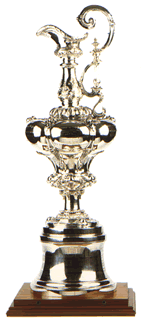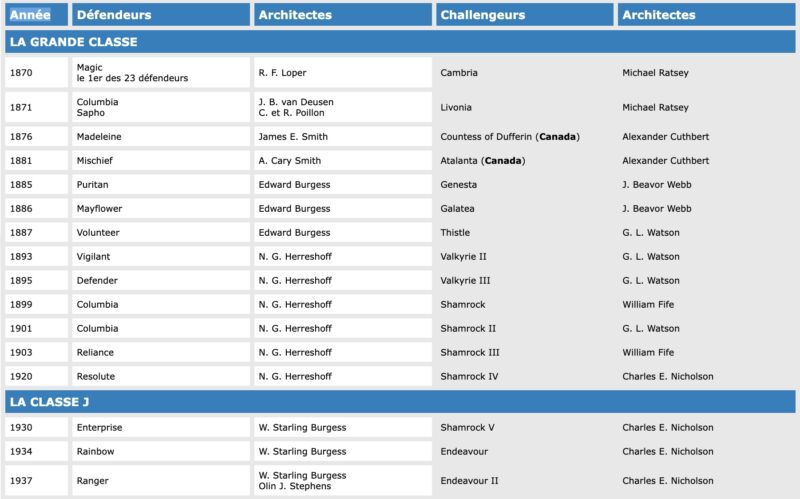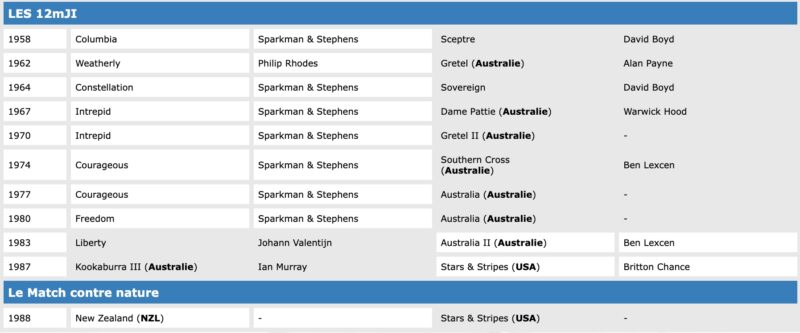An article by Voiles Classique
THE BIG CLASS, THE J CLASS & THE 12MJI

Known as the father of the America’s Cup in 1844 John Cox Stevens founded, with eight of his friends, the New York Yacht Club (NYYC) and was the Club’s first Commodore. His boat was called MARIA, a ballasted sloop with boomed jib (photo above) designed by Robert L. Stevens, (and brother of John Cox) and built in Hoboken in 1845. She was the first yacht to race in front of an audience.
Having been invited to the 1851 Universal Exhibition in London by the Commodore of the Royal Yacht Squadron Stevens was keen to display the shipbuilding skills of the United States. Accordingly the NYYC sent the schooner AMERICA to England, bought by John Cox Stevens, designed by George Steers (1820-1856) with a low freeboard and painted black she was built at the shipyard of William H. Brown (Manhattan Island, East River at the bottom of 12th Street) and helmed by Dick Brown, a pilot of the port of New York.
AMERICA won the race organised around the Isle of Wight on Friday August 22, 1851 … and thus won the Cup of One Hundred Sovereigns (guineas, pounds, …), perhaps by taking a shortcut. This trophy was to become the America’s Cup in 1857, the year of John Cox Stevens’ death, thanks to a 239-word deed of gift, the Deed of Gift, written in 1852 by Hamilton Wilkes and specifying the rules for a friendly competition between yacht clubs. The name ‘America’s Cup’ did not really appear until 1870, during the first challenge.
But let’s go back to August 22, 1851, that Black Friday of British yachting. Below is the body of water: the Isle of Wight, the Solent, Cowes (the Medina River and its mouth called the Roads), the Needles and the Nab lightship.



Observing his competitors, Stevens realised that his boat was under-canvassed: no balloon jib, only one boomed jib forward, only one jib on the main(aft) mast and, in addition, the masts had been shortened by 4 meters in New York …
He then obtained the right to cross his sails downwind, which was forbidden by the English rules, he also obtained that the regatta take place in real time without handicap and with a minimum wind, of 10 to 12 knots, finally he had a second jib added (made on site by George Ratsey) tacked on an extension of the bowsprit made locally by Michael Ratsey. His sails were cut flat while the British sails were rather full.

At 10 o’clock, seven schooners and eight cutters were at the start of the race that would change the history of yachting. The schooner AMERICA stumbled at the start (the sails are hoisted at the preparatory cannon shot and then weighed anchor), leaves in last position but quickly catches up with the fleet. The atmosphere is one of fierce competition with the English yachts determined to not let the Yankee challenger pass. But at the end of a regatta full of twists and turns and a serious controversy over the mark of the Nab Lights, the American schooner narrowly wins by crossing the line at 8:37 p.m. AMERICA is only 8 minutes ahead (we also read 18 minutes) of the small English cutter AURORA which crosses the finish line in the middle of general indifference, in the shadow of the black schooner. Not to mention the Irish cutter WILDFIRE, which came in first but was out of the race because it was refused by the Committee due to loose ballast…
A curious fact is added to the story: on the Cup, the name of the winner and those of the losers are engraved, except that of AURORA, which almost stole the show from AMERICA. Why is it not listed next to its racing companions? England feeds its myths. Was AURORA just a ghost ship? Or is it because that day there was no second?
The tradition of the America’s Cup was born.
The schooner AMERICA was sold to a British aristocrat, Lord de Blaquière, who resold her in 1853. In 1861 she belonged to a certain Decie who renamed her CAMILLA.
Finally she was destroyed under a hangar in a snowdrift at the beginning of 1942.

The America’s Cup, affectionately known as the ‘Auld Mug’, is an ornate sterling silv

er bottomless ewer crafted in 1848 by the goldsmiths and jewellers in London, Robert and Sébastien Garrard. Height 68 cm for 3.826 kg of solid silver.
The bottom was pierced in 1880 to allow a base to be bolted on.
Struck and damaged with hammer blows on 17 March 1997 by the Maori Benjamin Peri Nathan.
Evolution
The boats were of different sizes and performances and very quickly a measurement formula was developed allowing sailing boats of different lengths and shapes to compete on an equal footing.
The evolution is as follows:
1870 – First challenge, the Civil War is over, the measurement formula is based on the wetted surface (at the waterline) and the handicap is in seconds per mile of the course.
1871 – Introduction of the two-boat match instead of the one against all which prevailed, displacement is included in the formula, and boats can be changed during the competition.
1881 – No more schooners but sloops.
1885 – The sail area is introduced: Rating = 1/3 [ 2L + √S ]
In 1899 it becomes: Rating = 1/2 [ L + √S ]
The waterline length is close to that of the Deed of Gift, the sail area increases from 743 to 1220 m2.
1920 – The hull’s slenderness and finesse are taken into account.
1930 – The 1903 Regulations, those of the Universal Rule of the J Class are adopted. The rating is set at 76 feet.
Displacement limitation, replacement of the mainsail and jib rigs by the Bermudan rig. The waterline must be between 23.15 and 26.50 meters for an overall length of 36.60 meters and a displacement of 160 tons. The mast must not exceed 50 meters above the deck. The races are run in real time and no longer with handicap. In 1934 the formula was written: Rating = 1/√D [(0.18 x L x √S) + d] = 76
1956 – Adoption of the 1907 International Rule and the 12m JI for the 1958 Cup. The initial Cup regulations were in fact called into question by the English and Americans who wanted to compete on smaller and lighter boats than those initially provided for in the conditions of John Cox Stevens in 1857 (date on which the latter donated to the New York Yacht Club, under conditions, the famous Cup that he had won on the Isle of Wight waters on August 22nd, 1851). The New York courts ratified this evolution of the Deed of Gift. In particular, the obligation for the challenger to have to cross the Atlantic was removed.
1983 – For the first time since 1851, the Cup leaves the NYYC showcase: AUSTRALIA II beats LIBERTY
1987 – Abandonment of the 12mJI and, after the inconclusive episode of 1988, adoption of the America Cup Class (ACC).
In summary, below is a table of the first 27 challenges:
(The winner on a white background and, unless otherwise stated from 1962, the Defender is American, the Challenger is British)

AMERICA remained in the Navy until 1873 when she was sold to Benjamin Butler for $5,000. Butler raced and maintained her well with a restoration by Donald McKay in 1875 and a total refit in 1885 by Edward Burgess to keep her competitive.
Butler died in 1893 and his son Paul inherited the schooner but had no interest in her and gave her to his nephew Butler Ames in 1897. Ames reconditioned AMERICA and used her occasionally for racing and pleasure sailing until 1901 when she fell into disrepair. The boat was sold in 1917 to a company headed by Charles Foster and in 1921 was sold to the America Restoration Fund who donated her to the Naval Academy in Annapolis. It was not maintained any better and became seriously rotten by 1940.
The hangar that housed AMERICA collapsed during a heavy snowstorm on March 29, 1942. The remains of the hangar and ship were scrapped and burned in 1945.

This 9-foot-wide gilded American Eagle decorated the schooner’s crowning glory and was returned to the NYYC in 1912 along with the 1851 wheel and ensign.
Same article in French / Même article en français
LA GRANDE CLASSE, LES CLASSE J, LES 12mJI
Présentation

Le père de la Coupe America est John Cox Stevens qui, en 1844, fondait avec huit de ses amis le New York Yacht Club (NYYC) et en fut le Commodore (président en français).
Son bateau s’appelait MARIA, un sloop dériveur lesté à foc bômé (photo ci-dessus), plan Robert L. Stevens frère de John Cox, construit à Hoboken en 1845, le premier yacht à régater devant un public. Invité à l’Exposition Universelle de 1851 de Londres par le Commodore du RYS et souhaitant y afficher le niveau atteint par la technique de construction navale des Etats-Unis, le NYYC envoie en Angleterre la goélette AMERICA, achetée par John Cox Stevens, dessinée noire et basse de franc-bord par George Steers (1820-1856), construite au chantier de William H. Brown (Île de Manhattan, East River en bas de la 12ème Rue) et barrée par Dick Brown, un pilote du port de New-York.
AMERICA gagna la course organisée autour de l’île de Wight le vendredi 22 août 1851 … et remporta ainsi la Coupe de Cent Sovereigns (guinées, pounds, …), peut-être en prenant un raccourci. Ce trophée devait devenir la Coupe de l’America en 1857, année de la mort de John Cox Stevens, par la grâce d’un acte de donation de 239 mots, le Deed of the Gift, rédigé en 1852 par Hamilton Wilkes et spécifiant les règles d’une compétition amicale entre yacht-clubs. L’appellation Coupe de l’America n’est réellement apparue qu’en 1870, lors du premier défi.
Mais revenons au 22 août 1851, ce vendredi noir du yachting britannique. Ci-dessous le plan d’eau : l’Île de Wight, le Solent, Cowes (la Medina River et son embouchure appelée les Roads) les Needles et le bateau-phare du Nab.



En observant ses concurrents, Stevens se rend bien compte que son bateau est sous-toilé : pas de foc ballon, un seul foc bômé à l’avant, un seul flèche sur le mât arrière et, en plus, les mâts avaient été raccourcis de 4 mètres à New-York …
Il obtient alors le droit de croiser ses voiles au portant, ce qui était interdit par les règles anglaises, il obtient également que la régate ait lieu en temps réel sans handicap et avec un vent minimum, de 10 à 12 noeuds, enfin il fait ajouter un second foc (fabriqué sur place par George Ratsey) amuré sur une extension du boute-hors réalisée localement par Michael Ratsey. Ses voiles étaient taillées plates alors que les voiles britanniques étaient plutôt très creuses.
A 10 heures, sept goélettes et huit cotres prennent le départ de la course qui va changer l’histoire du yachting. La goélette AMERICA cafouille au départ (dit “à l’appareillage” : on hisse les voiles au coup de canon préparatoire puis on lève l’ancre), part en dernière position mais rattrape vite la flotte. L’ambiance est à la bagarre, les Anglais ne sont pas décidés à laisser passer le challenger yankee. Mais au terme d’une régate pleine de rebondissements et d’une sérieuse controverse sur la marque du Nab Lights, le voilier américain l’emporte de justesse en passant la ligne à 20 h 37. AMERICA devance de seulement 8 minutes (on lit aussi 18 minutes) le petit cotre anglais AURORA qui passe la ligne d’arrivée au milieu de l’indifférence générale, dans l’ombre de la goélette noire. Sans parler du cotre irlandais WILDFIRE arrivé en tête mais hors course car refusé par le Comité pour cause de lest mobile …
Un fait curieux s’ajoute à l’histoire : sur la Coupe, le nom du lauréat et ceux des perdants sont gravés, sauf celui d’AURORA qui a bien failli voler la vedette à AMERICA. Pourquoi ne figure-t-il pas à côté de ses compagnons de régate ? L’Angleterre nourrit ses mythes. AURORA n’était-il qu’un voilier fantôme ? Ou est-ce parce que ce jour là il n’y avait pas de second ?
La tradition de la Coupe de l’America est née.
La goélette AMERICA a été vendue à un aristocrate britannique, Lord de Blaquière qui l’a revendue en 1853. En 1861 elle appartient à un certain Decie qui la renomme CAMILLA.
Elle a été détruite sous son hangar dans un grain de neige au début de l’année 1942.

Coupe des Cent Guinées(The Old Mug, 1851). Aiguière façonnée en 1848 en 6 exemplaires par les orfèvres joaillers à Londres, Robert et Sébastien Garrard. Hauteur 68 cm pour 3,826 kg d’argent massif.
Le fond a été percé en 1880 pour permettre d’y boulonner un socle.
Frappée et abimée à coups de marteau le 17 mars 1997 par le Maori Benjamin Peri Nathan



Les bateaux étaient de taille et de performances disparates et très vite on chercha à mettre au point une formule de jauge permettant à des voiliers de longueurs et de formes différentes de combattre à égalité.
L’évolution est la suivante :
1870 – Premier défi, la Guerre de Sécession est terminée, la formule de jauge est basée sur la surface mouillée (à la flottaison) et le handicap est en secondes par mile du parcours.
1871 – Introduction du match à deux au lieu du un contre tous qui prévalait, le déplacement intervient dans la formule, on peut changer de bateau en cours de compétition.
1881 – Plus de goélettes mais des sloops.
1885 – On introduit la surface de la voilure : Rating = 1/3 [ 2L + √S ]
En 1899 elle devient : Rating = 1/2 [ L + √S ]
La longueur à la flottaison est proche de celle du Deed of the Gift, la surface de voilure passe de 743 à 1220 m2.
1920 – On tient compte des élancements et de la finesse de la coque.
1930 – C’est l’adoption du Règlement de 1903, celui de la Jauge Universelle de la Classe J (Nat Herreshoff). Le rating est fixé à 76 pieds.
Limitation du déplacement, remplacement des gréements auriques à grand-voile et flèche par le gréement bermudien. La flottaison doit être comprise entre 23,15 et 26,50 mètres pour une longueur hors tout de 36,60 mètres et un déplacement de 160 tonnes. Le mât ne doit pas dépasser 50 mètres au-dessus du pont. Les courses se courent en temps réel et non plus avec handicap.
En 1934 la formule s’écrit : Rating = 1/√D [(0,18 x L x √S) + d] = 76
1956 – Adoption de la Jauge Internationale de 1907 et du 12m JI pour la Coupe de 1958. Le règlement initial de la Coupe a en effet été remis en question par les Anglais et les Américains qui souhaitaient s’affronter sur des bateaux moins grands et moins lourds que ceux initialement prévus par les conditions de John Cox Stevens en 1857 (date à laquelle ce dernier fit donation au New York Yacht Club, sous conditions, de la célèbre Coupe qu’il avait remportée sur le plan d’eau de l’ile de Wight le 22 Août 1851). Les tribunaux de New York ont entériné cette évolution du Deed of the Gift. On a supprimé en particulier l’obligation pour le challenger d’avoir à traverser l’Atlantique.
1983 – Pour la première fois depuis 1851, la Coupe quitte la vitrine du NYYC : AUSTRALIA II bat LIBERTY
1987 – Abandon du 12mJI et, après l’épisode peu concluant de 1988, adoption du America Cup Class (ACC).
En résumé ci-dessous un tableau récapitulatif des 27 premiers défis :
(Le vainqueur sur fond blanc et, sauf mention à partir de 1962, le Défender est américain, le Challenger est britannique)

L’AMERICA est restée dans la Marine jusqu’en 1873, date à laquelle elle a été vendue à Benjamin Butler pour 5 000 $. Butler a couru et l’a bien entretenue avec une restauration par Donald McKay en 1875 et un réaménagement total en 1885 par Edward Burgess pour la garder compétitive.
Butler est décédé en 1893 et son fils Paul a hérité de la goélette mais il ne s’y intéressait pas et l’a donnée à son neveu Butler Ames en 1897. Ames a reconditionné l’AMERICA et l’a utilisée occasionnellement pour la course et la voile promenade jusqu’en 1901 quand elle est tombée en désuétude et délabrement. Le bateau a été vendu en 1917 à une entreprise dirigée par Charles Foster puis en 1921 a été vendu au America Restoration Fund qui l’a donné à la Naval Academy d’Annapolis. Il n’y a pas été mieux entretenu et est devenu sérieusement pourri en 1940.
Le hangar qui abritait l’AMERICA s’est effondré lors d’une forte tempête de neige le 29 mars 1942. Les restes du hangar et du navire ont été mis au rebut et brûlés en 1945.

Cet Aigle américain doré de 2,75 m de large décorait le couronnement de la goélette et a été restitué en 1912 au NYYC avec la barre à roue et le pavillon de 1851.











